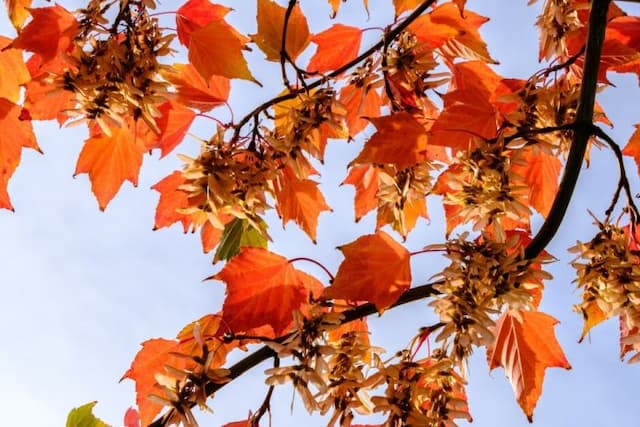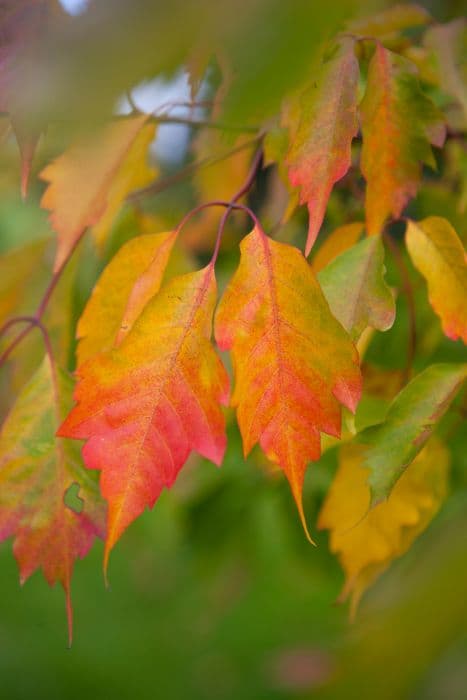Japanese Maple Acer japonicum 'Fairy Lights'

ABOUT
'Fairy Lights' is a type of Japanese maple known for its ornamental qualities and elegant foliage. In spring, the leaves unfurl in a delicate shade of light green, almost chartreuse, casting a soft, ethereal glow that justifies the name 'Fairy Lights'. The leaves are finely dissected, creating a lace-like pattern that becomes denser as the season progresses. Come fall, the foliage undergoes a dramatic transformation, adopting vibrant tones of orange, red, and purple, bringing a flamboyant display of autumnal color to any garden. With each leaf divided into narrow, elongated lobes, the overall effect is one of intricate detail and feathery texture. This plant's branching structure provides an open, layered aspect, which allows light to filter beautifully through the canopy, playing off the delicate foliage to create a serene and magical atmosphere. The leaves are typically small, contributing to the plant's delicate and refined appearance. The overall aesthetic of 'Fairy Lights' makes it a popular choice for gardeners looking to add a touch of grace and sophistication to their landscapes.
About this plant
 Names
NamesFamily
Sapindaceae
Synonyms
Japanese Maple, Full Moon Maple, Downy Japanese Maple
Common names
Acer japonicum 'Fairy Lights'.
 Toxicity
ToxicityTo humans
The Japanese Maple 'Fairy Lights' is not considered toxic to humans. There are no well-documented symptoms of poisoning from ingesting this plant, as it is generally not known to be poisonous.
To pets
The Japanese Maple 'Fairy Lights' is also not considered toxic to pets. Similar to humans, there are no significant symptoms of poisoning reported for pets ingesting this plant as it is not typically recognized as a toxic species.
 Characteristics
CharacteristicsLife cycle
Perennials
Foliage type
Deciduous
Color of leaves
Green
Flower color
Red
Height
10 feet (3 meters)
Spread
8 feet (2.4 meters)
Plant type
Tree
Hardiness zones
5
Native area
Japan
Benefits
 General Benefits
General Benefits- Aesthetic Appeal: Has delicate, fine-textured foliage that provides visual interest.
- Seasonal Interest: Offers vibrant fall colors for extended seasonal interest.
- Shade Tolerance: Grows well in partially shaded conditions, suitable for understory planting.
- Compact Growth: Smaller stature makes it suitable for residential gardens and small spaces.
- Minimal Maintenance: Requires relatively low maintenance once established.
- Drought Resistance: Once established, has some tolerance to drought conditions.
- Cold Hardy: Can withstand cold temperatures and is suitable for a range of climate zones.
 Medical Properties
Medical PropertiesThis plant is not used for medical purposes.
 Air-purifying Qualities
Air-purifying QualitiesThis plant is not specifically known for air purifying qualities.
 Other Uses
Other Uses- Insect habitat: The dense foliage of Japanese maple can provide shelter for various insects, which can be helpful for fostering local biodiversity.
- Photography subject: With its fine leaves and striking autumn colors, Japanese maple 'Fairy Lights' is a popular subject for photographers, especially in the fall.
- Culinary presentation: Small leaves from the Japanese maple can be used to add a decorative touch to gourmet dishes.
- Artistic inspiration: The unique form and color of Japanese maple 'Fairy Lights' can inspire artists and be featured in paintings and other art forms.
- Bonsai: This plant is highly valued for the art of bonsai due to its compact size and attractive foliage, creating miniature landscapes for indoor decoration.
- Educational model: It can be used as a botanical model in schools to teach about plant biology and the characteristics of deciduous trees.
- Craft materials: Dried branches and leaves can be used in crafting, such as in the creation of wreaths or other decorative items for the home.
- Seasonal celebration: In Japan, the turning of Japanese maple leaves is celebrated during "momijigari," which is the autumn tradition similar to cherry blossom viewing in the spring.
- Water feature enhancement: Planted adjacent to ponds or water features, the reflection of Japanese maple 'Fairy Lights' can enhance the aesthetic appeal of water gardens.
- Feng Shui element: Japanese maple can be used in Feng Shui to create a balance of the five elements in the garden, particularly representing the wood element for growth and vitality.
Interesting Facts
 Feng Shui
Feng ShuiThe Japanese Maple is not used in Feng Shui practice.
 Zodiac Sign Compitability
Zodiac Sign CompitabilityThe Japanese Maple is not used in astrology practice.
 Plant Symbolism
Plant Symbolism- Endurance and Strength - Generally, maples, including the Acer japonicum, symbolize endurance and strength due to their ability to withstand a variety of conditions and their long-lasting nature.
- Beauty and Elegance - The 'Fairy Lights' variety, with its delicate and fine foliage, highlights the aesthetic beauty and grace which can be associated with a fairy-like quality.
- Balance and Practicality - Maples often stand for balance, owing to their symmetrical leaf structure, and practicality for their diverse uses and adaptability.
- Peace and Serenity - The smooth flowing lines and tranquil appearance of the 'Fairy Lights' can evoke feelings of calm and peacefulness in a garden setting.
- Welcoming - In the Japanese culture, maples, or "momiji," are often found at the entrance of temples, symbolizing a warm and inviting welcome to visitors.
 Water
WaterThe Japanese maple 'Fairy Lights' prefers consistently moist but not waterlogged soil. It should be watered deeply once or twice a week, depending on weather conditions, with approximately 1 to 2 gallons of water each time for a tree with a mature size of about 10 feet. During the growing season, when temperatures are higher and rainfall is less frequent, you might need to water more often to maintain moisture. Conversely, reduce watering in the winter when the tree is dormant and the soil remains wet longer. Always check the soil moisture level a few inches down to ensure it's not too dry before watering again.
 Light
LightJapanese maples like 'Fairy Lights' thrive best in a spot that offers dappled or partial sunlight. They can tolerate full sun in cooler climates, but in areas with intense summer heat, it is crucial to provide some afternoon shade to prevent leaf scorch. An ideal location would be where the plant is shielded by larger trees or structures during the hottest part of the day.
 Temperature
TemperatureJapanese maples 'Fairy Lights' are cold-hardy and can typically survive temperatures as low as -20°F to -10°F, but prefer a temperate climate. The ideal temperature range for this cultivar is between 60°F and 75°F, although it can tolerate summer highs up to 90°F if provided with adequate moisture and shade. They are best suited for USDA zones 5 through 7.
 Pruning
PruningPrune Japanese maple 'Fairy Lights' to maintain its shape and health, typically during dormancy in winter or early spring before new growth starts. Remove dead or crossed branches and thin out dense areas to allow light and airflow. The best time is when the tree is still dormant to minimize sap loss, which can attract pests.
 Cleaning
CleaningAs needed
 Soil
SoilThe Japanese Maple 'Fairy Lights' thrives best in well-draining soil that is rich in organic matter. A mixture of loam, peat moss, and perlite in equal parts is ideal, ensuring good aeration and moisture retention. The soil pH should be slightly acidic to neutral, ideally ranging between 5.5 and 7.0.
 Repotting
RepottingThe Japanese Maple 'Fairy Lights' should be repotted every 2 to 3 years, or when it becomes root-bound. Spring is the best time for repotting to allow the plant to establish in its new container before the growing season.
 Humidity & Misting
Humidity & MistingThe Japanese Maple 'Fairy Lights' prefers the outdoor humidity levels typical of temperate climates. No extra humidity control is necessary; however, they do appreciate a location with some protection from harsh winds that can dry them out.
 Suitable locations
Suitable locationsIndoor
Place in bright, indirect light and avoid dry heat sources.
Outdoor
Choose a sheltered spot with dappled sunlight and mulch.
Hardiness zone
5-7 USDA
 Life cycle
Life cycleAcer japonicum 'Fairy Lights', commonly known as Fullmoon maple, begins its life cycle when the seeds fall to the ground in autumn and undergo stratification over the winter. In the spring, the seeds germinate, and young saplings sprout, gradually developing a root system and a stem with characteristic lobed leaves. Throughout the spring and summer, the sapling grows, undergoing photosynthesis and branching to form a more complex structure, eventually maturing into a small tree. As the tree matures over several years, it undergoes repeated seasonal cycles, with leaves unfurling in spring, transitioning to rich colors in autumn before being shed, and new growth occurring the following year. During its reproductive phase, which starts once the tree reaches a sufficient level of maturity, it produces inconspicuous red or purple flowers in the spring that develop into winged samaras, facilitating seed dispersal. Lastly, the Fullmoon maple can live for several decades, continuing its growth and reproduction cycle until it reaches senescence and eventually dies, completing its life cycle.
 Propogation
PropogationPropogation time
Late Summer-Early Fall
The most popular method of propagation for the Japanese maple 'Fairy Lights' is through grafting, particularly during the late winter to early spring months when the plant is still dormant. Grafting involves taking a piece of a branch, known as a scion, that includes buds from a 'Fairy Lights' Japanese maple and joining it to a rootstock, which is typically from a more common or hardy Japanese maple variety. This is done by making a diagonal cut in both the scion and the rootstock, then fitting them together so that the cambium layers match up. They are then bound tightly with grafting tape or a similar material to hold them together. For best results, the grafted plants should be kept in a humid environment until the graft union has completely healed and the scion has begun to grow, indicating a successful graft.









